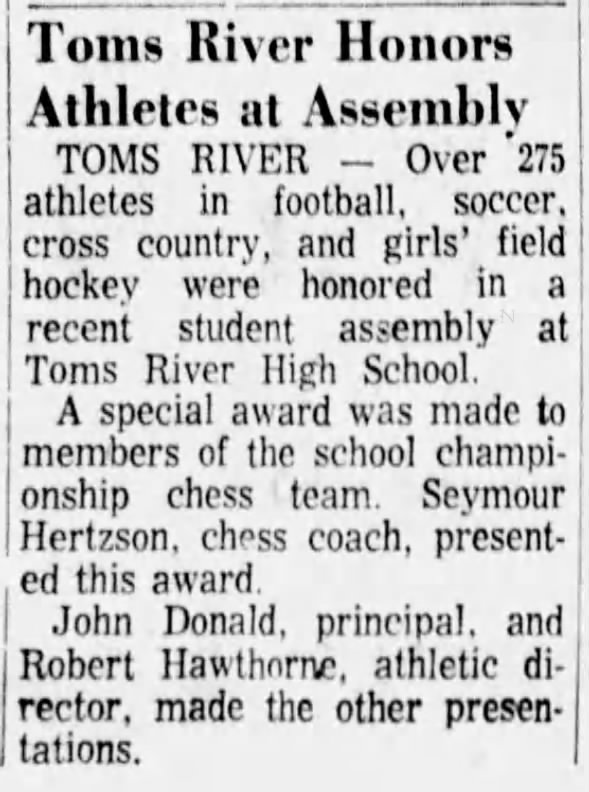 The Chessboard: Spassky Held to Draw by Evans 19 Jan 1969, Sun Asbury Park Press (Asbury Park, New Jersey) Newspapers.com
The Chessboard: Spassky Held to Draw by Evans 19 Jan 1969, Sun Asbury Park Press (Asbury Park, New Jersey) Newspapers.com
The Chessboard: Spassky Held to Draw by Evans by Harry T. Conover, Press Staff Writer
Grandmaster Boris Spassky of the Soviet Union this spring will face his countryman, Tigran Petrosian, in a match for the world chess championship.
Spassky earned his chance at the title by fighting his way through the World Chess Federation's interzonal tournament and candidates' matches emerging finally as the challenger after defeating Victor Korchnoi, also of the Soviet Union, in the final candidates' match.
For Spassky this will be the second time around, for he played and lost a match with Petrosian in 1966. But this early defeat is not looked on by observers as an indication of how the forthcoming match will come out.
These observers point out that Spassky has come a long way since that match and at 31 has reached the peak of his powers. They point to his record of 11 wins, 13 draws and only 2 losses in the candidates' matches as evidence that he fully deserves his chance to play for the title—and this time, they say, he is likely to be successful.
Be that as it may, Spassky came up against the United States champion, Larry Evans of New York, in the 18th Chess Olympics in Lugano, Switzerland, and had to be content with a draw in the following exciting game.
Larry Evans vs Boris Spassky
Lugano Olympiad Final-A (1968), Lugano SUI, rd 6, Oct-30
English Opening: King's English Variation. Closed System Full Symmetry (A26) 1/2-1/2
1. c4 e5 2. Nc3
Theory has it that 2. … N-KB3 is better here, preparing for the early push of the queen's pawn. An interesting alternative is 2. … P-KB4; 3. P-K3 N-KB3; 4. P-Q4 P-K5; 5. N-R3 B-N5; 6. B-Q2 O-O; 7. Q-N3 BxN; 8. BxB P-Q3; 9. N-B4 and White gets a slight edge.
2. …Nc6 3. g3 g6 4. Bg2 Bg7 5. d3 d6 6. Rb1 Here 6. P-B4 KN-K2; 7. N-B3 B-N5; 8. O-O O-O; 9. P-KR3 BxN; 10. BxB N-B4; 11. K-R2 PxP; 12. BxP leads to advantage for White.
6. … f5 Signaling his intention to play for a kingside attack in the face of White's assault on the opposite wing.
7. b4 Nf6 8. b5 In view of White's lagging development, this may be premature.
8. … Ne7 9. e4 O-O 10. Nge2 a6 11. a4 axb5 12. axb5 fxe4 13. Nxe4 Nxe4 14. Bxe4 c6 15. bxc6 bxc6 16. Bg5 Qa5+ 17. Bd2 Qa7 Black's little play-by-play has secured a commanding position for his queen and gained him some elbow room.
18. O-O Bh3 19. Ra1 White has failed to obtain even a whisper of an advantage from the opening and it now is Black who is shaping the future course of the game.
19. … Qb7 20. Rxa8 Qxa8 21. Re1 d5 This push in the center poses a direct threat to the White king who occupies a precarious position.
22. cxd5 cxd5 23. Bh1 Qa7 24. Be3 d4 25. Bg5 Bg4 26. Qc2 Nf5 27. Nc1 Nd6 Black prepares for P-K5, after which White would be faced with numerous threats.
28. Qa2+ Qxa2 29. Nxa2 Re8 White has forced the exchange of queens, but their disappearance has not made his defense any easier. With this move Black strengthens the threat of P-K5.
30. Nb4 h6 31. Bd2 Bf5 32. Bd5+ Kh7 33. f3 Nb5 34. f4 Nc3 35. Bf3 Bd7 36. fxe5 Rxe5 37. Rxe5 Bxe5 38. Kf2 Kg7 39. Bxc3 Giving Black an advanced passed pawn as well as the advantage of the two bishops. At this point it is hard to see how White can hold the game, but the text bespeaks his confidence that he can.
39. … dxc3 40. Ke3 Ba4 41. d4 Bd6 42. Na2 c2 43. Kd2 Be7 44. Kc3 Ba3 45. Kd2 Kf6 46. Be4 Bb3 47. Nc1 White is holding on grimly against the powerful two bishops.
47. … Bb4+ 48. Kd3 Ba4 49. Bb7! ! White finds the saving move, looking to the advance of the queen's pawn to offset Black's advantage in his pawn on the seventh rank.
49. … Ke7 50. d5 The logical follow up to White's previous move.
50. … Ba3 51. Kd2 Kd6 52. Bc6 A draw is now the likely outcome.
52. … Bxc1+ 53. Kxc1 Bb3 54. Be8 Drawn. Endgame play of a high order by Evans.
 Hirsute Visage Seen Beneficial 19 Jan 1969, Sun Asbury Park Press (Asbury Park, New Jersey) Newspapers.com
Hirsute Visage Seen Beneficial 19 Jan 1969, Sun Asbury Park Press (Asbury Park, New Jersey) Newspapers.com
 Toms River Honors Athletes at Assembly 20 Jan 1969, Mon Asbury Park Press (Asbury Park, New Jersey) Newspapers.com
Toms River Honors Athletes at Assembly 20 Jan 1969, Mon Asbury Park Press (Asbury Park, New Jersey) Newspapers.com






















